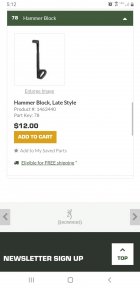You are using an out of date browser. It may not display this or other websites correctly.
You should upgrade or use an alternative browser.
You should upgrade or use an alternative browser.
Smith & Wesson “Hillary Hole”?
- Thread starter Tommie
- Start date
Function, as in the kinematic design? No, other than the lock, which is passive when disengaged.
Mechanically, many of the parts are MIM, which really pisses off the purists.
Mechanically, many of the parts are MIM, which really pisses off the purists.
Dusty Stevens
Shiner
Lots more parts with a transfer bar than if the firing pin was just on the hammer. Way more parts to jam up
Ok. Didn’t know about the “new” models having a transfer bar. That definitely changes things.Lots more parts with a transfer bar than if the firing pin was just on the hammer. Way more parts to jam up
shoot4fun
Gold $$ Contributor
The Hilary Hole? Never heard it called that before. Yes, the keyhole on the side right above the cylinder release for locking the mechanism and preventing operation of the revolver.
@Tommie the transfer bar has been incorporated into S&W revolvers (all others too to my knowledge) to keep a sharp blow to the hammer from setting off the primer underneath it in the cylinder. It has been there since the late 80's (maybe longer).
I do, in fact, know of a person who was misfortunate enough to have their S&W wheel gun go off while strapped in the holster. It happened when the butt of a shotgun rapped the hammer spur in just the perfect way. It was many years ago and before the transfer bar.
During my time working for S&W I talked at length to many of the "old-timers" about failures in either the key lock or transfer bar system that rendered the revolver inoperable. No one could relate any story where an unmolested (home gunsmith) had failed due to either.
Even Ruger single-actions have a transfer bar system.
@Tommie the transfer bar has been incorporated into S&W revolvers (all others too to my knowledge) to keep a sharp blow to the hammer from setting off the primer underneath it in the cylinder. It has been there since the late 80's (maybe longer).
I do, in fact, know of a person who was misfortunate enough to have their S&W wheel gun go off while strapped in the holster. It happened when the butt of a shotgun rapped the hammer spur in just the perfect way. It was many years ago and before the transfer bar.
During my time working for S&W I talked at length to many of the "old-timers" about failures in either the key lock or transfer bar system that rendered the revolver inoperable. No one could relate any story where an unmolested (home gunsmith) had failed due to either.
Even Ruger single-actions have a transfer bar system.
matthias
Gold $$ Contributor
Its not a transfer bar. It is a hammer block. It is not required to set the rounds off. In a ruger if you remove the transfer bar the gun doesn't go bang. In the smith if you remove it it will shoot just fine. It may also shoot if you hit the hammer. Hence the name hammer block. Its a safety of sorts.The Hilary Hole? Never heard it called that before. Yes, the keyhole on the side right above the cylinder release for locking the mechanism and preventing operation of the revolver.
@Tommie the transfer bar has been incorporated into S&W revolvers (all others too to my knowledge) to keep a sharp blow to the hammer from setting off the primer underneath it in the cylinder. It has been there since the late 80's (maybe longer).
I do, in fact, know of a person who was misfortunate enough to have their S&W wheel gun go off while strapped in the holster. It happened when the butt of a shotgun rapped the hammer spur in just the perfect way. It was many years ago and before the transfer bar.
During my time working for S&W I talked at length to many of the "old-timers" about failures in either the key lock or transfer bar system that rendered the revolver inoperable. No one could relate any story where an unmolested (home gunsmith) had failed due to either.
Even Ruger single-actions have a transfer bar system.
Attachments
shoot4fun
Gold $$ Contributor
I started calling it a transfer bar when S&W went to a firing pin in the frame instead of on the hammer.Its not a transfer bar. It is a hammer block. It is not required to set the rounds off. In a ruger if you remove the transfer bar the gun doesn't go bang. In the smith if you remove it it will shoot just fine. It may also shoot if you hit the hammer. Hence the name hammer block. Its a safety of sorts.
shoot4fun
Gold $$ Contributor
S&W revolvers went thru so much engineering and manufacturing change over the years it's hard to keep up with. Guess that is why the old guns (heyday guns) bring such hefty sums.Whatever......the image that term conjures up is repugnant to the nth degree.
Two piece barrels, hammer blocks and even key holes didn't bother me near as much as the switch to all MIM hammers and triggers instead of forged parts and the frame mounted firing pin.
I think the frame mounted firing pin was a great idea. I've had both designs, and I never pierced a primer on a frame mounted firing pin gun.I started calling it a transfer bar when S&W went to a firing pin in the frame instead of on the hammer.
matthias
Gold $$ Contributor
The other fun thing about the mim parts is that once you wear through the hard layer the part needs to be replaced. Very few people wear through the hard layer shooting, most are "smoothing the action out". Then they can't figure out why it feels different every range trip.
shoot4fun
Gold $$ Contributor
This!The other fun thing about the mim parts is that once you wear through the hard layer the part needs to be replaced. Very few people wear through the hard layer shooting, most are "smoothing the action out". Then they can't figure out why it feels different every range trip.
Have a gunsmith do an action job and even attempt to get close to what the old guns could be.
That MIM part is not through hardened like the original forged part.
This!
Have a gunsmith do an action job and even attempt to get close to what the old guns could be.
That MIM part is not through hardened like the original forged part.
That brings up an interesting point. Conventional wisdom says Ruger revolvers need lots of dry fire break-in but doesn’t Ruger use MIM for just about everything?The other fun thing about the mim parts is that once you wear through the hard layer the part needs to be replaced. Very few people wear through the hard layer shooting, most are "smoothing the action out". Then they can't figure out why it feels different every range trip.
shoot4fun
Gold $$ Contributor
At least IF that surface hardening is done correctly.I think the rugers really suffer from sharp edges and surface finish of the internal parts. Also I would bet money even committed revolver shooters will not shoot enough to naturally wear through the hard surface. With abrasives it is all too easy
BUT, the committed ones will do an immense amount of dry-fire practice and that is the same as actual shooting on the internals.
No, Ruger uses fewer MIM parts, and more cast parts. My understanding is that Ruger leads the casting industry for high performance cast small steel parts, especially stainless.. . . but doesn’t Ruger use MIM for just about everything?
Having worked both, I think Ruger's "need more break in" because the mechanism prioritizes robustness over delicacy.
shoot4fun
Gold $$ Contributor
So, your "handle" here isn't because of kids/grandkids then?I think the frame mounted firing pin was a great idea. I've had both designs, and I never pierced a primer on a frame mounted firing pin gun.
If you are popping primers regularly in a revolver it is not the fault of the firing pin location.
When the frame mounted firing pin guns get smoothed up and springs worked over they always get extra length firing pins from Cylinder & Slide to keep them shooting.
Yes the "handle" is/was because of kids I have twin daughters, hence I was "POP" twice. The pierced primers were all with factory ammo of various brands. All were with a Smith and Wesson Model 19 and a foreign made copy of a Colt SAA both with the hammer mounted firing pin. I can't verify absolutely that was the cause, but I've read this is a common malady with these guns that have a hammer mounted firing pin, including the original Colts as well. A guy that I used to work with also had a Smith and Wesson Model 19 that pierced primers, his also had the hammer mounted firing pin. The later .357 Mags that I own/have owned all had a frame mounted firing pin and none of these has ever pierced a primer. Not absolute science, but my observation.So, your "handle" here isn't because of kids/grandkids then?
If you are popping primers regularly in a revolver it is not the fault of the firing pin location.
When the frame mounted firing pin guns get smoothed up and springs worked over they always get extra length firing pins from Cylinder & Slide to keep them shooting.
Upgrades & Donations
This Forum's expenses are primarily paid by member contributions. You can upgrade your Forum membership in seconds. Gold and Silver members get unlimited FREE classifieds for one year. Gold members can upload custom avatars.

Click Upgrade Membership Button ABOVE to get Gold or Silver Status.
You can also donate any amount, large or small, with the button below. Include your Forum Name in the PayPal Notes field.
To DONATE by CHECK, or make a recurring donation, CLICK HERE to learn how.

Click Upgrade Membership Button ABOVE to get Gold or Silver Status.
You can also donate any amount, large or small, with the button below. Include your Forum Name in the PayPal Notes field.
To DONATE by CHECK, or make a recurring donation, CLICK HERE to learn how.











